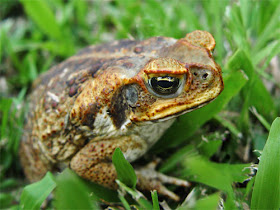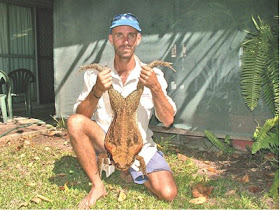Beauty Of Animal | Cane Toad | The Cane Toad (Bufo marinus), also known as the Giant Neotropical Toad or Marine Toad, is a large, terrestrial true toad which is native to Central and South America, but has been introduced to various islands throughout Oceania and the Caribbean. It is a member of the subgenus Rhinella of the genus Bufo, which includes many different true toad species found throughout Central and South America. The cane toad is a prolific breeder females lay single-clump spawns with thousands of eggs.
The cane toad is an old species. A fossil toad (specimen UCMP 41159) from the La Venta fauna of the late Miocene of Colombia is indistinguishable from modern cane toads from northern South America. It was discovered in a floodplain deposit, which suggest that marinus habitat preferences have always been for open areas. The cane toad has poison glands, and the tadpoles are highly toxic to most animals if ingested.
Originally, cane toads were used to eradicate pests from sugar cane, giving rise to their common name. The cane toad has many other common names, including "Giant Toad" and "Marine Toad"; the former refers to its size and the latter to the binomial name, Bufo marinus. Other common names include "Giant Neotropical Toad", "Dominican Toad", "Giant Marine Toad", and "South American Cane Toad". In Trinidadian English they are commonly called "Crapaud", the French word for toad. The subgenus Rhinella is increasingly considered to constitute a distinct genus of its own, thus changing the scientific name of the Cane Toad.
Juvenile cane toads may be confused with species of the Uperoleia genus, but their adult colleagues can be distinguished by the lack of bright colouring on the groin and thighs. In the United States, the cane toad closely resembles many Bufonid species. In particular, it could be confused with the Southern toad (Bufo terrestris), which can be distinguished by the presence of two bulbs in front of the parotoid glands. The cane toad is very large the females are significantly longer than males, reaching an average length of 10–15 cm (3.9–5.9 in). "Prinsen", a toad kept as a pet in Sweden, is listed by the Guinness Book of Records as the largest recorded specimen.
The skin of the cane toad is dry and warty. It has distinct ridges above the eyes, which run down the snout. Individual cane toads can be grey, yellowish, red-brown or olive-brown, with varying patterns.A large parotoid gland lies behind each eye. Predators outside the cane toad's native range include the Whistling Kite (Haliastur sphenurus), the Rakali (Hydromys chrysogaster), the Black Rat (Rattus rattus) and the Water Monitor (Varanus salvator). There have been occasional reports of the Tawny Frogmouth (Podargus strigoides) and the Papuan Frogmouth (Podargus papuensis) feeding on cane toads. It is likely that an opossum of the Didelphis genus can eat cane toads with impunity.
Traditionally, within the toad's natural range in South America, the Embera-Wounaan would "milk" the toads for their toxin, which was then employed as an arrow poison. Other modern applications of the cane toad include pregnancy testing, as pets, laboratory research, and the production of leather goods. The tests using toads were faster than those employing mammals: toads were easier to raise, and, although the initial 1948 discovery employed Bufo arenarum for the tests, it soon became clear that a variety of anuran species were suitable, including the cane toad. . Even dead toads have value. Cane toad skin has been made into leather and novelty items stuffed cane toads, posed and accessorised, have found a home in the tourist market, and attempts have been made to produce fertilizer from their bodies
Find Here The Kinds Of Animals and Flora and Fauna
Animal Flora and Fauna





